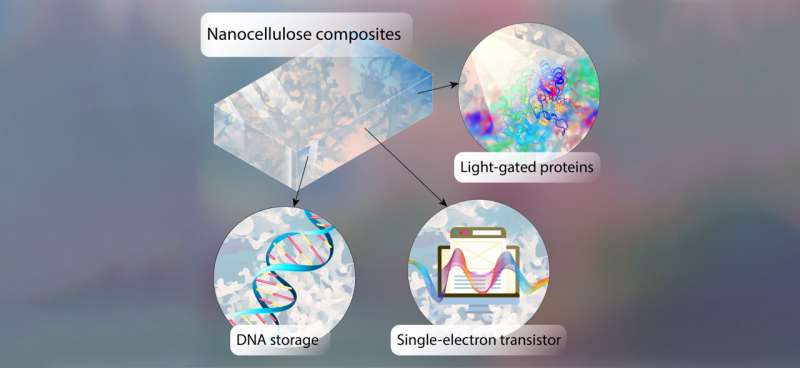This article has been reviewed according to Science X's editorial process and policies. Editors have highlighted the following attributes while ensuring the content's credibility:
fact-checked
peer-reviewed publication
trusted source
proofread
Study outlines what challenges need to be overcome to make DNA chips more applicable as storage media

The hereditary molecule DNA can store a great deal of information over long periods of time in a very small space. For a good 10 years, scientists have therefore been pursuing the goal of developing DNA chips for computer technology, for example for the long-term archiving of data. Such chips would be superior to conventional silicon-based chips in terms of storage density, longevity, and sustainability.
Four recurring basic building blocks are found in a DNA strand. A specific sequence of these blocks can be used to encode information, just as nature does. To build a DNA chip, the correspondingly coded DNA must be synthesized and stabilized. If this works well, the information is preserved for a very long time—researchers assume several thousand years. The information can be retrieved by automatically reading out and decoding the sequence of the four basic building blocks.
What challenges have to be overcome
"The fact that digital DNA data storage with high capacity and a long lifespan is feasible has been demonstrated several times in recent years," says Professor Thomas Dandekar, head of the Chair of Bioinformatics at Julius-Maximilians-Universität (JMU) Würzburg. "But the storage costs are high, close to 400,000 US dollars per megabyte, and the information stored in the DNA can only be retrieved slowly. It takes hours to days, depending on the amount of data."
These challenges must be overcome to make DNA data storage more applicable and marketable. Suitable tools for this are light-controlled enzymes and protein network design software. Thomas Dandekar and his chair team members Aman Akash and Elena Bencurova discuss this in a recent review in the journal Trends in Biotechnology.
Dandekar's team is convinced that DNA has a future as a data store. In the journal, the JMU researchers show how a combination of molecular biology, nanotechnology, novel polymers, electronics and automation, coupled with systematic development, could make DNA data storage useful for everyday use possible in a few years.
DNA chips made of nanocellulose
At the JMU Biocentre, Dandekar's team is developing DNA chips made of semiconducting, bacterially produced nanocellulose. "With our proof of concept, we can show how current electronics and computer technology can be partially replaced by molecular biological components," says the professor.
In this way, sustainability, full recyclability and high robustness even against electromagnetic pulses or power failures could be achieved, but also a high storage density of up to one billion gigabytes per gram of DNA.
Thomas Dandekar rates the development of DNA chips as highly relevant. "We will only last as a civilization in the longer term if we make the leap into this new type of sustainable computer technology combining molecular biology with electronics and new polymer technology," said Dandekar.
What is important for humanity, he said, is to move to a circular economy in harmony with planetary boundaries and the environment. "We need to achieve this in 20 to 30 years. Chip technology is an important example of this, but the sustainable technologies to produce chips without e-waste and environmental pollution are not yet mature. Our nanocellulose chip concept makes a valuable contribution to this. In the new paper, we critically examined our concept and advanced it further with current innovations from research."
Dandekar's team is currently working on combining the DNA chips made of semiconducting nanocellulose even better with the designer enzymes they have developed. The enzymes also need to be further improved. "In this way, we want to achieve better and better control of the DNA storage medium and be able to store even more on it, but also save costs and thus step by step enable practical use as a storage medium in everyday life."
More information: Aman Akash et al, How to make DNA data storage more applicable, Trends in Biotechnology (2023). DOI: 10.1016/j.tibtech.2023.07.006
Elena Bencurova et al, Nanocellulose Composites as Smart Devices With Chassis, Light-Directed DNA Storage, Engineered Electronic Properties, and Chip Integration, Frontiers in Bioengineering and Biotechnology (2022). DOI: 10.3389/fbioe.2022.869111
Rana Salihoglu et al, PRO-Simat: Protein network simulation and design tool, Computational and Structural Biotechnology Journal (2023). DOI: 10.1016/j.csbj.2023.04.023
Elena Bencurova et al, DNA storage—from natural biology to synthetic biology, Computational and Structural Biotechnology Journal (2023). DOI: 10.1016/j.csbj.2023.01.045
Journal information: Computational and Structural Biotechnology Journal , Trends in Biotechnology
Provided by Julius-Maximilians-Universität Würzburg





















